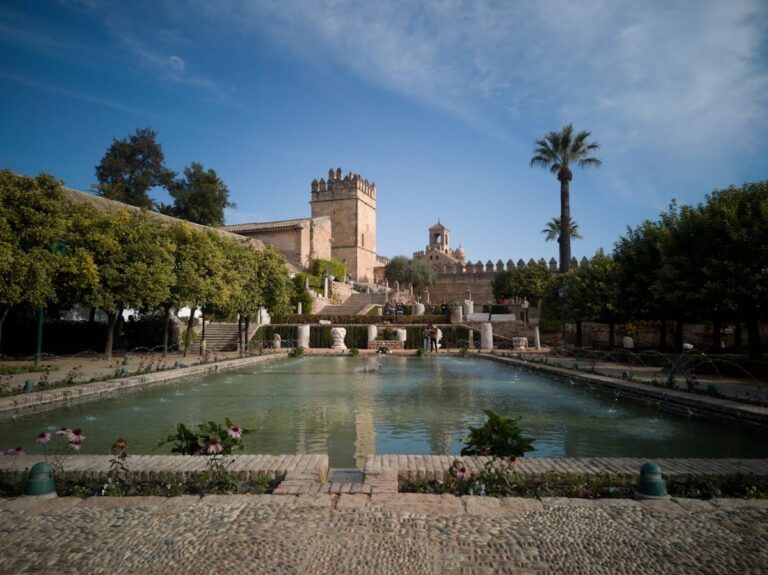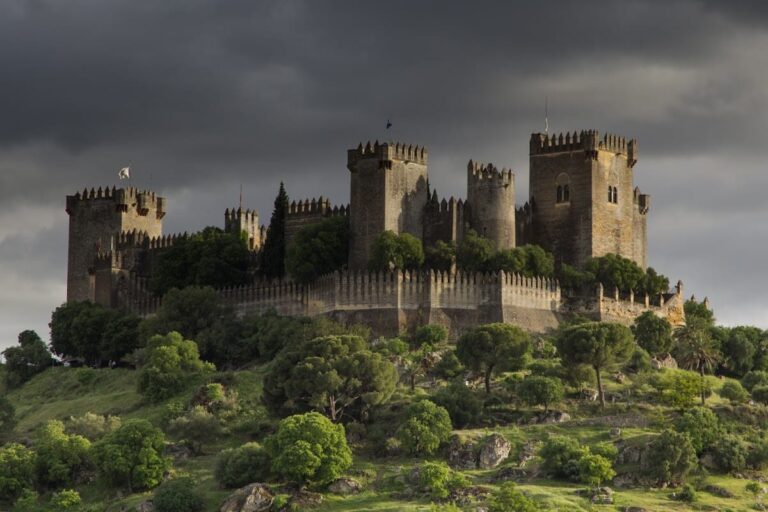Alcázar de los Reyes Cristianos: A Historic Fortress in Córdoba, Spain
Visitor Information
Google Rating: 4.6
Popularity: Medium
Google Maps: View on Google Maps
Official Website: cultura.cordoba.es
Country: Spain
Civilization: Unclassified
Remains: Military
History
The Alcázar de los Reyes Cristianos is located in the city of Córdoba, Spain. The site originally hosted a Roman castellum, a military camp or fortress, dating back to the 5th century.
During the early medieval period, this Roman structure was replaced by an Umayyad Alcázar, a palace-fortress built during the Muslim rule of Al-Andalus. Later, in the late 12th century, the Muslim Almohad dynasty constructed a fortress known as an alcazaba on the site, probably under the reign of Caliph Abu Yaacub Yusuf around 1171-1172.
In 1236, after the Christian forces led by King Fernando III captured Córdoba, the Alcázar complex was divided among the king, the bishop, noble families, and the military Order of Calatrava. Significant building work began under King Alfonso XI in 1328 and continued until around 1350. This period saw major reforms, including the addition of baths built in the Mudéjar style, which blended Christian and Islamic artistic influences.
The Alcázar served as a royal residence for Castilian monarchs, most notably monarchs Isabella I and Ferdinand II, known as the Catholic Monarchs. They used the fortress as their residence during the Granada War in the late 15th century. A notable event during this time was the captivity of the Nasrid emir Boabdil in 1483; he was held at the Alcázar before his release on the condition that he became a vassal to the Catholic Monarchs.
Following the conquest of Granada in 1492, the Alcázar became the seat of the Spanish Inquisition tribunal, a religious court tasked with rooting out heresy. The Inquisition remained active at the fortress until its abolition in 1812. Afterward, the building was converted into a civil prison, a function it retained until the period of the Second Spanish Republic.
Throughout its history, the fortress played a role in several military conflicts, including the Castilian civil war in the 14th century and the War of Succession during the reign of Enrique IV. The Alcázar also hosted important occasions such as royal weddings and political meetings. Christopher Columbus, seeking royal funding for his voyage, made his appeal to the crown in the Tower of Homage at the Alcázar in 1486. Parts of the fortress, including the baths, were used by the Inquisition as torture chambers.
In the 20th century, the Alcázar was declared a Historic Monument in 1931 and underwent extensive restoration starting in the 1950s. These efforts culminated in its public reopening in 1960. Since 1994, it has been part of Córdoba’s UNESCO World Heritage historic center. More recent restoration projects from 2015 to 2025 have focused on archaeological recovery, improving accessibility, and strengthening structural conservation. Notably, the original Baroque gate was reopened in 2023, and work continues on the Tower of Homage and the Hall of Mosaics.
Remains
The Alcázar de los Reyes Cristianos is a fortress arranged roughly in a square layout and defined by four principal towers, each with its own history and function. The northeast corner is dominated by the octagonal Tower of Homage, once known as the Clock Tower, which has served multiple roles including housing royal and judicial activities. On the northwest corner stands the square Tower of the Lions, the oldest surviving tower dating from the 13th century. This tower features lion-shaped gargoyles and contains the Chapel of San Eustaquio, highlighting a religious use associated with the Christian period.
At the southwest corner is the circular Tower of the Inquisition, reconstructed under King Enrique IV. This tower was used to store archives related to the Spanish Inquisition, reflecting the fortress’s judicial role during that era. The southeast corner hosts the Tower of the Dove, a square tower rebuilt in the 20th century to replace one that had been demolished in the 19th century.
Inside the Alcázar, the Salón de los Mosaicos stands as an 18th-century hall that was originally the Inquisition’s chapel. It is adorned with eight Roman mosaics dating from the 2nd to 3rd centuries and depicts various mythological scenes. The hall also contains an exceptionally well-preserved Carrara marble sarcophagus from the 3rd century, decorated with representations of the gates of Hades and the mythological winged horse Pegasus.
The Royal Baths, sometimes called Baños de Doña Leonor or Baños árabes, consist of four rooms arranged sequentially: a changing room followed by cold, temperate, and hot rooms. These baths, which likely originated during the Almohad period, were heated by a water system located underneath the Tower of Homage. The baths were later adapted and reused by Christian occupants. Star-shaped skylights punctuate the ceilings, allowing natural light to illuminate the spaces.
The Patio de crucero or Mudéjar Courtyard occupies the western side of the fortress. It has a square plan and is enclosed by galleries with arches except on the west side, where a solid wall connects the Towers of the Lions and the Inquisition. A central fountain is flanked by two ponds, preserving much of the courtyard’s original arrangement uncovered during 20th-century repairs.
On the eastern side lies the Patio de las Mujeres, named during the prison era because it was the section designated for female inmates. Archaeological work from 2002 to 2004 revealed remains spanning several periods here, including Roman walls dating to the 1st century, mosaics, and industrial structures from the 3rd century. Almohad fortification walls up to six meters high were also uncovered in this area, alongside a medieval cloaca or sewer.
The Sala de recepciones, also referred to as the Reception Hall or Ocean Hall, is located near the Salón de los Mosaicos. This square room houses a Roman mosaic dedicated to Oceanus, a mythological sea deity. It contains furnishings from the 17th and 18th centuries, including choir seats and a bust of Gonzalo Fernández de Córdoba, linking the space to later historical figures.
Surrounding the fortress are extensive gardens covering approximately 55,000 square meters, arranged on three terraces. The Higher Garden, created in the mid-20th century, sits between the Tower of the Lions and the Royal Stables. Below it is the Middle Garden, formerly known as the Garden of the Inquisitors, planted with orange and lemon trees. The Lower Garden dates from the mid-20th century as well and features a formal, orthogonal design with fountains and ponds. Water for irrigation is supplied by the ancient Roman Aqua Fontis Aureae aqueduct, which brings water from the Sierra Morena mountains.
A notable feature outside the main walls is the Paseo de los Reyes or Promenade of the Kings. This cypress-lined avenue is divided by two long narrow ponds and includes sculptures representing the monarchs who contributed to building the Alcázar. It also features a grouping of statues showing the Catholic Monarchs alongside Christopher Columbus, commemorating their historical connection to the fortress.
The fortress’s fabric incorporates diverse building materials reflecting its layered history. Roman masonry remains visible in the lower walls and foundations, while towering Almohad fortifications rise as high as six meters. Decorative elements in the Mudéjar style provide intricate geometric and floral motifs. Marble, particularly Carrara marble, is used in sculptural pieces like the sarcophagus. Restoration efforts over the 20th and 21st centuries have included repairs to fountains, marble paving, and the reconstruction of battlements, ensuring the preservation of this multi-period site.










